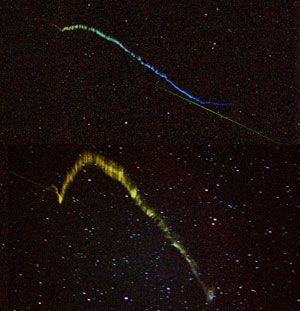 A pair of glowing trails left by meteors.
A pair of glowing trails left by meteors.
Picture courtesy of Carter Roberts.They're called "shooting stars"--and I'm not referring to John Wayne or Clint Eastwood. I mean meteors, and they'll be spicing up the skies near you in less than two weeks.
First the news flash: The Perseid Meteor Shower, August 12, by the dark of the Moon! Be there. This year's Perseid shower coincides with the night of New Moon, so there will be no moonlight brightening the night, and it will be much easier to spot the fainter meteors and achieve a high sighting count for the night. How many meteors you count is the measuring stick of your success….
A "Perseid" is a meteor--shooting star, falling star, what have you--belonging to the Perseid Meteor Shower, an annual flurry of these brilliant atmospheric streakers that takes place on and around August 12. Their name comes from the fact that these meteors appear to come from the direction of the constellation Perseus.
The Perseid shower is notable in that it boasts one of the highest meteor rates of any of the annual showers. I've read different figures, but under good viewing conditions (no clouds, dark sky), one might expect to see as many as 50 or 60 meteors per hour. The ones you miss when you blink don't count, though.
Most meteor showers actually take place over a spread of days surrounding the expected shower peak date, sometimes spanning a couple of weeks or more. But these showers tend to start off slow, rise toward a peak activity night, and then taper off--so generally the best time to view a shower is within a day or so of the peak.
